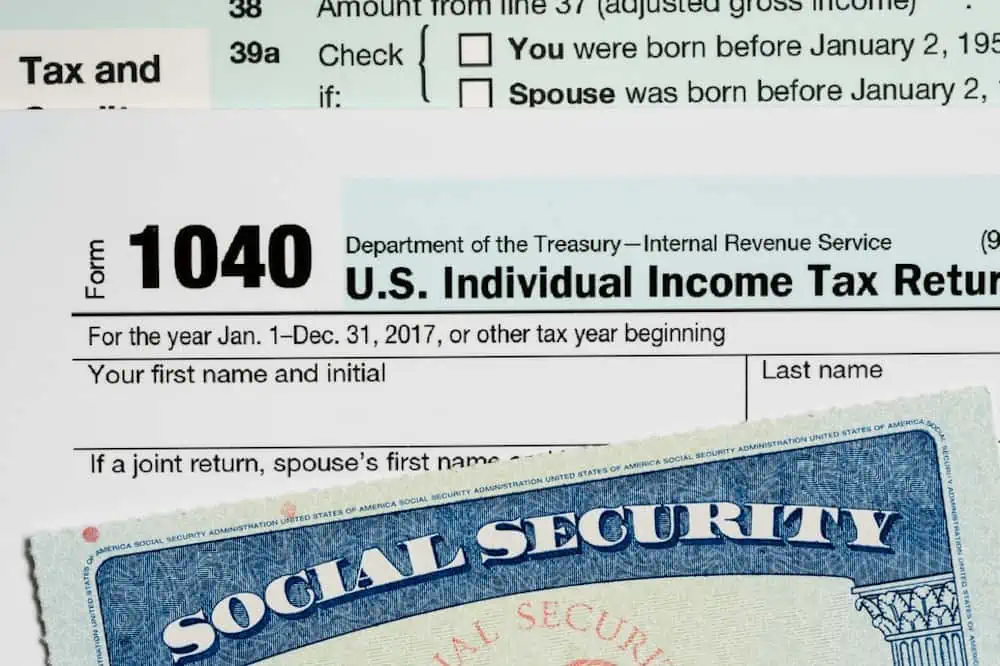You’ve worked hard your entire life and look forward to enjoying your retirement years. But did you know that a portion of your Social Security benefits might be subject to federal taxes? Whether you owe taxes on your Social Security income depends on your overall income, including other sources like pensions, rental income, or retirement account distributions.
Fortunately, the strategies outlined below can help you minimize or even completely avoid taxes on Social Security benefits. The key is reducing the taxable income included in your provisional income. If the combined income that makes up your provisional income is lower, then you might end up paying taxes on a smaller percentage of your Social Security benefits. If the percentage is lower, then so will the tax bill on your benefits.
Table of Contents
How Federal Taxes on Social Security Are Calculated

Before getting into the methods for lowering or avoiding taxes on your Social Security benefits, a quick review of how Social Security taxes work is probably useful.
Let’s start with by defining “provisional income,” which is generally the combined total of your modified adjusted gross income (AGI), your tax-exempt interest, and 50% of your Social Security benefits. If you’re filing a joint tax return, include amounts for both spouses when calculating your provisional income.
Young and the Invested Tip: In most cases, your modified AGI is equal to the AGI reported on your federal income tax return, minus any income tax deduction or exclusion for student loan interest, employer-provided adoption benefits, foreign earned income or housing, and income earned by residents of American Samoa or Puerto Rico.
Will I Owe Tax on My Social Security?

In a nutshell, you won’t owe taxes on any of your Social Security income if your provisional income is below the following thresholds:
— $32,000 or less for married couples filing a joint return
— $25,000 or less for single filers, head-of-household filers, surviving spouses, and married people filing separately who lived apart from their spouse for the entire year
If your provisional income is above the applicable threshold amount, you’ll owe taxes on some of your Social Security. If you’re married and filing a separate tax return, you’ll also pay federal income tax on a portion of your Social Security benefits, regardless of your provisional income, if you lived with your spouse for any part of the tax year.
How Much of Your Social Security is Taxable?

How much of your Social Security is taxable if your provisional income is above the threshold is as follows:
— For married couples filing a joint return, up to 50% of your Social Security income is taxed if your provisional income is between $32,001 and $44,000, while you’ll pay income tax on up to 85% of your benefits if your provisional income is more than $44,000.
— For single filers, head-of-household filers, surviving spouses, and married people filing separately who lived apart from their spouse for the entire year, you’ll pay tax on up to 50% of your Social Security benefits if your provisional income is between $25,001 and $34,000. If your provisional income is more than $34,000, up to 85% of your benefits will be taxed.
— Married taxpayers filing a separate federal tax return who lived together for any part of the year will pay income tax on up to 85% of their Social Security payments.
Related: Don’t Believe These 17 Social Security Myths
How to Avoid Taxes on Social Security Benefits

With some basic knowledge about Social Security taxes in hand, let’s now dive into how you can avoid, or at least minimize, taxes on Social Security benefits.
The secret is reducing the taxable income—other than your Social Security benefits—that makes up your modified AGI. Once that figure comes down, so will your provisional income. And if your provisional income is reduced enough, the amount of Social Security income subject to tax could drop from 85% to 50%, or from 50% to nothing.
So, without further ado, here are several ways to avoid or minimize taxes on your Social Security benefits. Any single method might not impact taxes on your Social Security income, so look for multiple tax-saving opportunities that might work for you. We recommend working with a qualified tax advisor or financial advisor to create a comprehensive retirement income plan that’s right for you.
Related: What’s Your Standard Deduction?
1. Contribute to Traditional Retirement Accounts

If you still work while receiving Social Security benefits, you can still contribute to a traditional IRA or 401(k) account. While the money you earn from your job will increase your AGI, the amount you contribute to traditional retirement accounts will bring it back down a bit. That’s because those contributions will be on a “pre-tax” basis—meaning they won’t be included in your AGI.
Young and the Invested Tip: With a traditional IRA, you will have to claim a tax deduction to remove any contributions from your gross income, while contributions to a traditional 401(k) account aren’t included as wages on your W-2 form.
For 2024, anyone 50 years of age or older can contribute up to $8,000 to an IRA (up from $7,500 in 2023). In most cases, IRA contributions also can’t exceed your earned income for the year.
There’s also a limit on annual contributions to 401(k) plans, which must be made before the end of each calendar year. For 2024, the limit for people age 50 or older is $30,500 (up from $30,000 in 2023).
Related: Best Vanguard Retirement Funds for a 401(k) Plan
Young and the Invested Tip: Contributions to an IRA for the 2023 tax year can be made up to April 15, 2024 (April 17 for residents of Maine and Massachusetts). If you put money in an IRA in 2024 before that date, make sure you let the account administrator know that your contribution is for the 2023 tax year.
Related: IRA vs. 401(k): How These Retirement Accounts Differ
2. Withdraw Money From Traditional Retirement Accounts Before Social Security Payments Begin

If you have a traditional IRA or 401(k) account, consider withdrawing funds from the account before you start receiving Social Security benefits. Why? Because distributions from these traditional retirement accounts are included in your AGI, which increases your provisional income.
Related: Best Schwab Retirement Funds for a 401(k) Plan
This will also impact required minimum distributions (RMDs) from the account down the road, since the amount of each RMD is based on the account balance at the end of the previous tax year. So, you’ll have smaller RMDs once you start receiving Social Security benefits if you draw down the account before getting benefits. And, since RMDs from traditional retirement accounts are taxable, that also means you’ll have less combined income to boost your provisional income when you’re receiving Social Security benefits.
Related: Best Retirement Plans for 2024 [Workplace + Individual]
3. Do a Roth Conversion Before Social Security Payments Begin

Unlike traditional IRAs and 401(k) plans, you don’t have to pay taxes on distributions from Roth IRAs or Roth 401(k) accounts. While you don’t get a tax break when you make contributions to these retirement accounts like you do with traditional IRAs or 401(k) plans, you get tax-free retirement income when you take the money out of Roth IRAs and Roth 401(k) accounts.
If you have money in a traditional account, you can roll it over into a Roth IRA or Roth 401(k) account before you start drawing Social Security. This process is known as a Roth conversion. That way, when you withdraw money down the road from the Roth account, it won’t be included in your AGI, so it won’t raise your provisional income. That, in turn, might help you minimize taxes on your Social Security benefits in the future.
Related: Best Vanguard Retirement Funds for a 401(k) Plan
But there’s a catch! When you transfer funds from a traditional retirement account to a Roth IRA or Roth 401(k), you’ll have to pay taxes on the amount rolled over in the year of the conversion. The IRS isn’t going to let you get away with completely avoiding federal taxes on money in the traditional account. Plus, tax-free withdrawals of earnings from a Roth IRA are generally not allowed for five years after a Roth conversion.
Related: Best Fidelity Retirement Funds for a 401(k) Plan
4. Contribute to a Health Savings Account

As with contributions to traditional IRAs and 401(k) plans, contributions to a health savings account are generally made on a pre-tax basis. As a result, you might be able to claim a tax deduction for contributions to an HSA, which will reduce your AGI.
Related: When Are Taxes Due? [2024 Tax Deadlines]
There are several important restrictions, though. For example, you have to be covered under a high-deductible health plan (HDHP) to contribute to an HSA. The HDHP must also satisfy certain requirements regarding annual deductibles and maximum out-of-pocket expenses.
As with IRAs and 401(k) plans, there are also annual HSA contribution limits. If you have self-only coverage under an HDHP and are at least 55 years old at the end of the year, you can contribute up to $6,300 for 2025 (up from $6,150 for 2024). If you have family coverage in 2025 and are at least 55 by year’s end, the limit is $9,550 (up from $9,300 for 2024).
In addition, you can’t contribute to an HSA or claim the deduction if you’re enrolled in Medicare. However, people who claim Social Security before turning 65 won’t have to worry about this restriction.
You also can contribute to an HSA if you can be claimed as a dependent on someone else’s federal return.
5. Set Up a Qualified Charitable Distribution

Charitable-minded seniors who are at least 70½ years old can reduce their gross income by setting up a qualified charitable distribution (QCD) from an IRA. With a QCD, up to $105,000 can go directly from your IRA to charity in 2024 (up from $100,000 in 2023). Since you don’t touch the money in between, it isn’t included in gross income and doesn’t increase your provisional income.
Like Young and the Invested’s content? Be sure to follow us.
A QCD of up to $53,000 can be made to a charitable remainder annuity trust, charitable remainder unitrust, or charitable gift annuity in 2024 (up from $50,000 in 2023). The catch is that you can only make this type of QCD once.
QCDs offer another advantage that can help reduce taxes on your Social Security benefits: The amount distributed from a traditional IRA as a QCD counts toward your RMD. That means you’ll have to withdraw fewer additional funds from your IRA to satisfy the RMD rules, which means less taxable retirement income included in your provisional income.
Related: RMDs for Roth 401(k) Accounts No Longer Required
6. Manage Capital Gains and Losses

Do you dabble in the market or have stocks tucked away in taxable accounts? If so, you might be able to reduce your AGI—and, thus, your provisional income—through careful management of those assets.
One way is to hold on to appreciated stocks and other capital assets if your provisional income is close to one of the threshold amounts that can trigger a greater portion of your Social Security income being taxed. Pushing the sale of those assets to the following year will also push back the infusion of capital gain into your gross income. If that means you end up holding an asset for more than one year, you’ll also benefit from lower capital gains tax rates.
On the other hand, if you have stocks or other assets that have decreased in value, selling them to realize capital losses can help you trim Social Security taxes. The losses can be used to offset capital gains, which will reduce your gross income. Plus, if losses exceed gains, then some of the losses can also be used to reduce other income that would otherwise be included in your provisional income. The strategy of selling assets to generate capital losses that will offset gains or other income is known as “tax-loss harvesting.”
Young and the Invested Tip: Watch out for the wash sale rule if you’re selling stock to generate a loss. The rule basically says you can’t offset capital gains or claim a deduction against ordinary income with losses from the sale of stock or securities if you buy or otherwise acquire the same or substantially identical stock or securities within 30 days before or after the sale.
Related: Capital Gains Tax: What Is It, Rates, Home Sales + More
7. Be Careful With Municipal Bonds

Ordinarily, investing in municipal bonds can cut your tax bill. That’s because you don’t have to pay income tax on the interest you receive from state or local government bonds (at least not on the federal level).
Related: 5 Best Vanguard Dividend Funds [Low-Cost Income]
However, remember that provisional income includes any nontaxable interest. So, while you might not have to pay tax on interest from municipal bonds, that interest could push your provisional income past one of the thresholds used to determine the percentage of your Social Security benefits that are subject to tax. As a result, consult with your financial advisor before creating a retirement income strategy that relies too heavily on nontaxable interest from municipal bonds.
Related: 5 Best Fidelity Retirement Funds [Low-Cost + Long-Term]
8. Manage Self-Employment Deductions and Income

Many retirees continue to work after they begin receiving Social Security payments, and many of them work for themselves as consultants, daycare providers, freelance writers, or other gig workers. So, if you’re self-employed, make sure you take all the deductions against business income you’re entitled to on Schedule C (Form 1040). By reducing your taxable net profit, or even generating a business loss, you’ll lower your modified AGI and, as a result, lower your provisional income, too.
Other tax deductions for self-employed people might be available, too. For example, if you’re self-employed, you might be able to deduct a portion of your self-employment tax, contributions to a Simplified Employee Pension (SEP) account, or health-insurance premiums for yourself and your family. All of these deductions will help lower your gross income.
If you’re close to paying taxes on a larger portion of your Social Security benefits, consider pushing year-end invoices into the next year. That can push some of your taxable income from self-employment to the next year.
Related: Solo 401(k) vs. SEP IRA: What’s the Difference?
9. Purchase a Qualified Longevity Annuity Contract (QLAC)

A qualified longevity annuity contract (QLAC) might also help reduce the federal income tax on your Social Security benefits. Basically, a QLAC is an annuity contract that’s purchased with funds in an IRA, 401(k), or similar retirement account. Annuity payments start at a predetermined date, but no later than your 85th birthday, and continue for the rest of your life. You can use up to $200,000 of retirement account funds to purchase a QLAC in 2024 (same amount as allowed in 2023). All in all, QLACs are often a good option for people who are worried about outliving their retirement account savings.
Related: 5 Best Vanguard Retirement Funds [Start Saving in 2024]
So, how can QLACs lower taxes on your Social Security benefits? By lowering your RMDs without adding taxable income on your return until the annuity payments begin. The retirement funds used to purchase a QLAC aren’t counted when your RMD amount is calculated each year. That means you’ll have to withdraw less taxable income from your traditional retirement accounts each year, which means a lower provisional income.
Careful planning is required with QLACs, though. Once the annuity payments begin, you’ll have more taxable income. So, down the road, federal taxes on your Social Security could potentially rise.
Related: How to Start a Retirement Plan
10. Move to a Different State

So far, we’ve only talked about federal taxes on Social Security income. However, 10 states tax Social Security benefits to one extent or another in 2024. Those states are Colorado, Connecticut, Kansas, Minnesota, Montana, New Mexico, Rhode Island, Utah, Vermont, and West Virginia.
Like Young and the Invested’s content? Be sure to follow us.
If you live in one of these states and are paying state income taxes on your Social Security benefits, consider moving to a different state—maybe even to a jurisdiction with no state income tax at all. Yes, that can be a big step. But if you’re thinking of relocating in retirement anyway, make sure you at least check out the state tax burden for retirees in the new state before packing your bags.
Related: 2 States Repeal Tax on Social Security Benefits [Do You Live In One of Them?]
11. Withholding or Estimated Taxes for Social Security Payments

While it won’t actually reduce the federal taxes owed on your Social Security benefits, you can cut the tax bill due when you file your return by having federal taxes withheld from your Social Security payments. It’s easy to have taxes withheld from payments. Just complete Form W-4V and send it to your local Social Security Administration office. Taxes can be withheld at either a 7%, 10%, 12%, or 22% rate.
If you don’t want to have federal taxes withheld from your Social Security payments, you can make quarterly estimated tax payments instead. Form 1040-ES is used to file and pay estimated taxes, although you can also file and pay electronically on the IRS website. Worksheets in the instructions for Form 1040-ES will help you calculate the amount of each estimated payment.
With either method, you’re simply paying taxes in advance. So, when it’s time to file your tax return, you then get to subtract any amount withheld or estimated taxes paid from what you would otherwise owe. This can also result in a larger tax refund, which usually makes people pretty happy.
Like Young and the Invested’s content? Be sure to follow us.
Related: What Tax Bracket Are You In?

Perhaps the best way to lower your federal income tax bill is push yourself down into a lower tax bracket to reduce your tax rate. On the flip side, you certainly want to avoid getting kicked into a higher bracket and increasing your tax rate.
But, of course, under either scenario you need to have a good feel for where you are right now. For that purpose, check out the federal tax brackets and rates that will apply for your next federal tax return.
Related: Don’t Believe These 17 Social Security Myths

Lots of misinformation circulates around Social Security: Is it solvent? Will it fold? Will retirees have Social Security ten years from now? Most of these are myths perpetuated time and again. Fortunately, we’ve created a comprehensive list of Social Security myths and debunk each one of them.
Related: How Are Social Security Benefits Taxed?

In many cases, Social Security benefits are subject to federal taxation. To learn how your Social Security benefits are taxed, we’ve got an entire guide to walk you through the calculation.
Related: 10 States That Tax Social Security Benefits

While most states don’t subject Social Security benefits to taxation, at least 10 states do tax Social Security. To see if you live in one of them, or you’re considering a relocation for retirement and taxation of your Social Security is a sticking point, we’ve got you covered with all of the details.
Like Young and the Invested’s content? Be sure to follow us.





